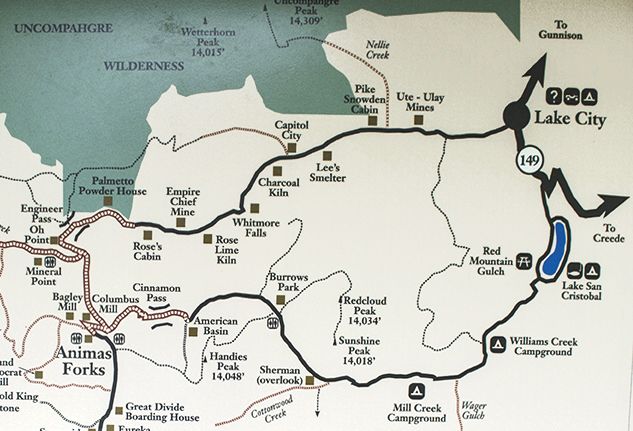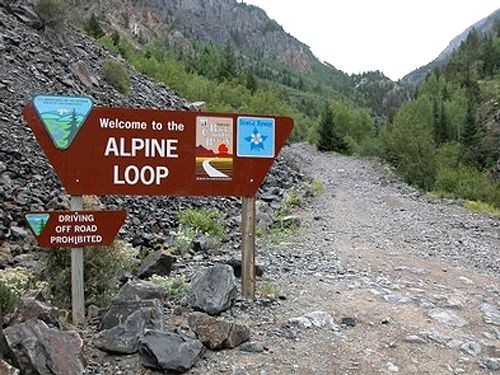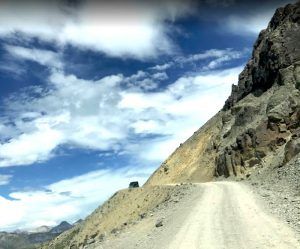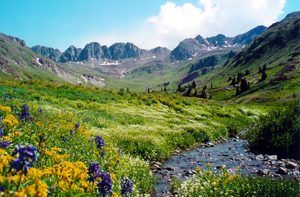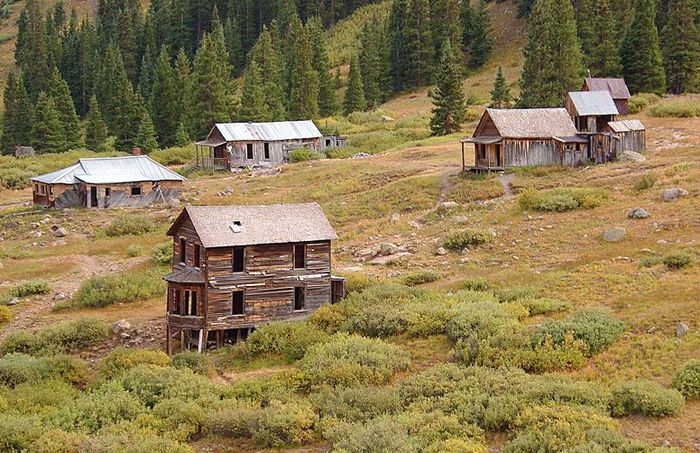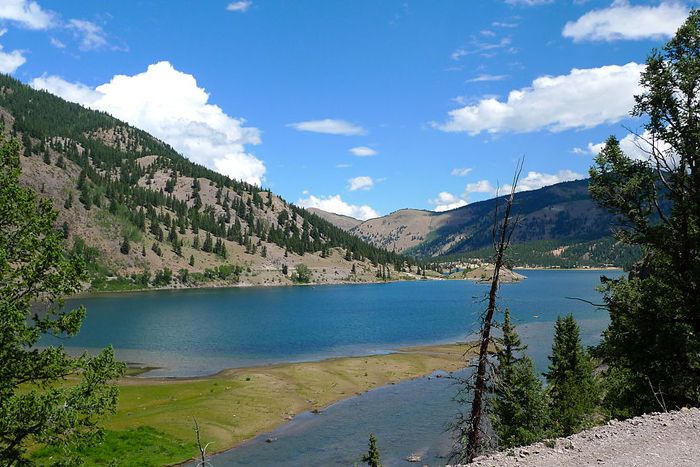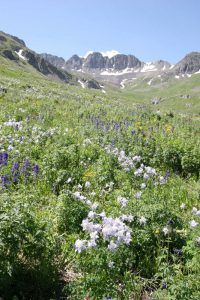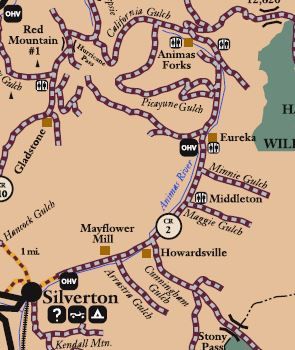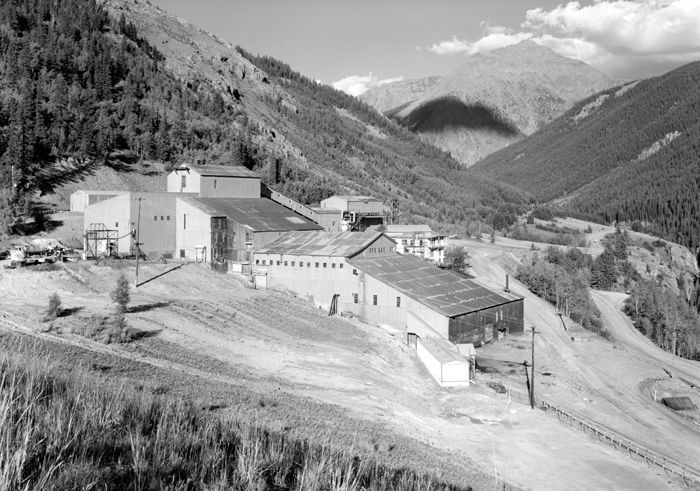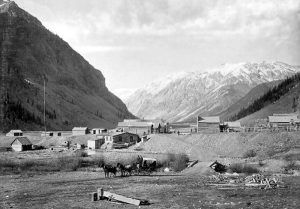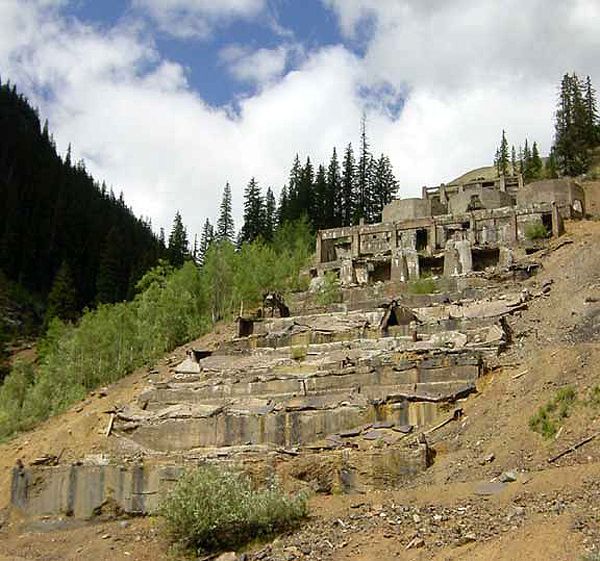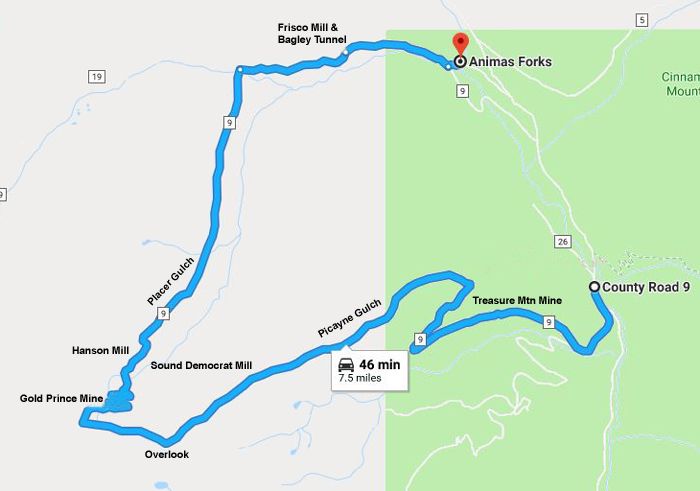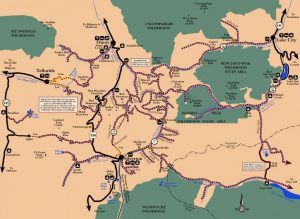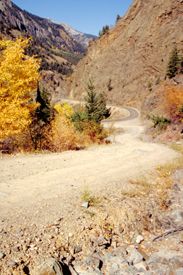Tucked away in the San Juan Mountains of southwestern Colorado is the Alpine Loop National Backcountry Byway. Located northeast of Silverton, Colorado in San Juan and Hinsdale Counties, the circular route makes its way from Lake City south along CO-149, to County Road 30, which turns west over Cinnamon Pass to Animas Forks, and then returns east over Engineer Pass back to Lake City along County Road 20.
Sculpted by the forces of volcanoes, glaciers, wind, and rain, the resulting mountains, valleys, streams, and lakes are a masterpiece of nature’s artistry. The Ute Indian tribe long inhabited this area before they were replaced by miners in the 1800s, who came in search of silver, gold, lead, and zinc. These hardy pioneers carved a network of roads through this rugged terrain to enable them to transport ore and supplies by mule-drawn wagons to and from Silverton, Ouray, and Lake City.
Today, the mines and mills are closed but, the roads still remain. Many still visible exploration pits and tunnels give evidence of extensive prospecting. The Hidden Treasure, Ute-Ulay, Golden Fleece, Little Giant, and Pride of the West mines are only a few of the more than 70 mines with lodes that beckoned 19th-century entrepreneurs. Many of the area mining towns such as Animas Forks, Mineral Point, and Capitol City boomed when the railroad brought mobility and transportation to Lake City. Now, only the skeletons of these ghost towns remain.
This system of historic roads is now the Alpine Loop National Backcountry Byway. Part of the National Scenic Byway system, the Alpine Loop was one of the Bureau of Land Management’s first backcountry byways. Unlike most scenic byways, located on paved highways, backcountry byways focus on the out-of-the-way sights to be found on gravel and dirt roads. These are routes are not suitable for all vehicles; however, for those with appropriate transportation, backcountry byways offer views of a variety of areas off the beaten track.
The backcountry byway covers 65 miles of roads between Lake City, Ouray, and Silverton, Colorado. Depending on winter snow, the Loop opens about late May/early June and closes in late October. Today, visitors can follow the routes used by the prospectors, miners, and settlers that ventured into the mountains to seek their fortune. Portions of this road are not paved and require a four-wheel drive, high clearance vehicle. The Alpine Loop has narrow twists and blind curves.
In addition to the outstanding scenery, visitors enjoy a wide array of other outdoor recreation activities. The rivers, streams, and lakes attract fishermen and hikers to enjoy the many trails that can be accessed up to five peaks over 14,000 feet.
History buffs will want to explore the many structures, mines, and ghost towns left over from the late 1800s. Photographers will especially appreciate the abundance of colorful alpine wildflowers in late July/early August and the explosion of fall colors during September.
The Alpine Loop has rustic facilities, including three campgrounds, a picnic area, and 10 restrooms along the way. The driving time of the Alpine Loop is estimated at 4-6 hours. The loop can be accessed from Lake City, Silverton, or Ouray.
The Alpine Loop is truly a backcountry experience. Make sure someone knows your travel plans and do your homework before you start your trip. Make sure you have plenty of water, food, and fuel to make it to your destination. Electronics and wireless devices DO NOT work in most places on the Alpine Loop. It is recommended that you download or print hard copy maps before your trip.
The main loop is only part of the experience as miles of designated side routes allow visitors to access several other sites.
Courtesy Rules of the Alpine Loop
- Stay on designated roads.
- Obey posted signs for parking and trails.
- Please drive slowly and watch for on-coming traffic.
- Stay on your side of the road on blind curves. Honk to warn on-coming traffic.
- Uphill traffic has the right-of-way.
- Do not park or stop on narrow sections of the road. Use pull-outs or wider areas of the road to park.
- The majority of the traffic moves in a clockwise manner — it is highly suggested you do so also. This helps with traffic jams on the narrow shelf sections of this route.
Sites along the Main Alpine Loop:
Animas Forks – This town was established in 1875 and was occupied until the 1920s. Retaining several historic buildings, it is one of the most popular destinations along the popular Alpine Loop National Backcountry Byway. This was once a bustling community with numerous buildings and mill sites. Today, it displays nine buildings, including the two-story Duncan House, the Columbus Mill, and the jail structure, the oldest building on the site. Foundations and other falling buildings dot the area. Interpretive signs tell the history of the town. The Alpine Loop Road continues north along County Road 2 to Engineer Pass. In the other direction, San Juan County Road 2 makes its way southwest to Silverton. (See Silverton Road.) A side spur of the Alpine Loop, Co Rd 9, leads west of Animas Forks, making a loop around Treasure Mountain back to Co Rd 2. See Side Spur – County Road 9. Several mines and mills can be seen along this loop including the well preserved Sound Democrat Mill
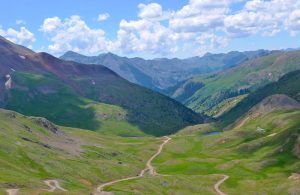
Engineer Pass on the Alpine Loop Backcountry Byway, by Robert Thigpen, Flickr
Mineral Point – From Animas Forks, San Juan County Road 2 makes its way upward to Engineer Pass. The trail comes to a crossroads 2.7 miles north of Animas Forks, with Co Rd 17 making its way to the left. About a mile to the west, mining remains can be seen in the valley below and there are several dirt trails into the valley. Mineral Point thrived from the 1870s through the 1890s. Co Rd 17 continues to the northwest, turning into Ouray County Road 18, before connecting with Highway 550 and north to Ouray. This road can be a difficult drive and some portions are recommended only for expert 4×4 drivers. Return east on Co Rd 17, and north onto Co Road 2 to continue the Alpine Loop Tour.
Engineer Pass – Located 2.3 miles north of the intersection Co Rd 17 and Co Rd 2, the trail reaches the summit of Engineer Pass. Sitting at an elevation of 12,800 feet, the views are spectacular. To the west is Mt. Sneffels at 14,150 feet, to the northeast is Uncompahgre Peak and at 14,309 feet, and to the east is the extinct Lake City volcanic caldera, which the Loop Road encircles. Otto Mears built the first toll road over Engineer Pass which was completed in 1877. The road became a major route connecting Silverton, Animas Forks, Ouray, and Lake City. As the Alpine Loop Trail crosses the pass, it enters San Juan County and becomes Hinsdale County Road 20.
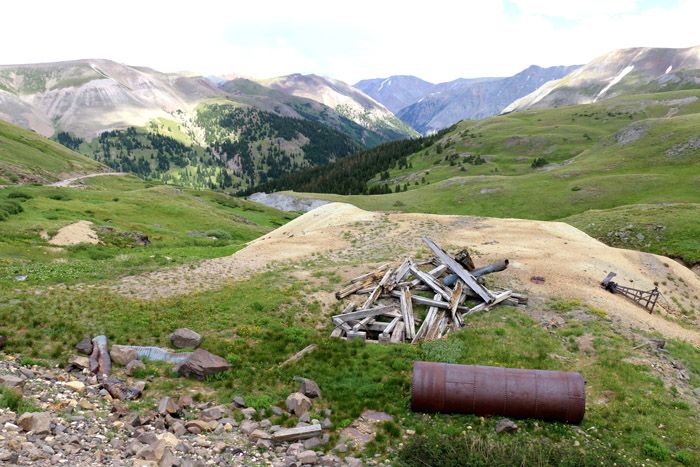
Palmetto Gulch Mine on the Alpine Loop Backcountry Byway by Extreme Geographer
Galena Mining District – Beyond Engineer Pass is the Galena Mining District, which stretched east from the Ouray-San Juan county line for 16 miles to Lake City. The Frank Hough Mine was situated near the top of Engineer Pass’s east side, approximately 500 feet from the Alpine Loop Trail. Along with the nearby Palmetto Mine and Mill, it was owned by John S. Hough, a good friend of Kit Carson who ran for Colorado governor in 1880. The greatest activity of these mines occurred in the early 1880s. Here, also once stood a mining camp called Engineer City. It was established in 1881 around the Frank Hough Mine. All that is left today of these mining operations is a portion of the Palmetto Gulch Powderhouse and scattered debris. A bit further down the road was the Empire Chief Mine, mill, and boarding house. The mine was originally discovered in 1885 and operated intermittently until 1930. It was stabilized in 2000 but unfortunately, it was destroyed by an avalanche in 2008. Today its fallen timbers can still be seen along the mountainside.
Rose’s Cabin – About three miles east of Engineer Pass’s summit is a sign for Rose’s Cabin. The initial cabin was built in 1874 by Corydon Rose and grew into a saloon, hotel, stable, store, post office. A mining camp was also established here that had about 50 people. Everyone was gone by 1900. Today, all that is left are the timbers of an old building and an old safe sitting in the meadow.
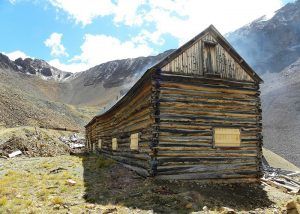
Golconda Mine Boarding House, courtesy HistoriCorps
Golconda Mine – Beyond Rose’s cabin, travelers come to the intersection of Co Rd 20 and Co Rd 21. The latter makes its way across Henson Creek for 1.5 miles to the old Golconda Mine. The mining complex consists of the century-old Golconda Boarding House and Compressor House. Stabilized in 2015, the boarding house is the largest remaining standing log structure on the east side of the Alpine Loop that is accessible to the public. The compressor building is located southeast of the boarding house and still contains intact machinery distinct to hard rock mining.
Rose Lime Kiln – Back on Hinsdale County Road 20, travelers will soon come to Rose’s Lime Kiln. It was built in by George S. Lee, who also owned the Lee Mining & Smelting company at Capitol City. Standing 44 feet tall, it once produced an ash-free lime that was used as a cement additive. The kiln was named after Rose Lee, the daughter of George and Mary Jane Lee. It is listed in the National Register of Historic Places.
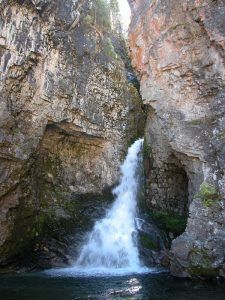
Whitmore Falls near Lake City, Colorado by Parkerpics
Whitmore Falls – Located just about ten miles west of Lake City is Whitmore Falls situated near the trail. It is marked by a wooden sign reading: “Whitmore Falls Scenic Overlook.” It is a short downhill walk to the observation point and well worth it for a sensational photo opportunity.
Capitol City – Just two miles beyond the waterfall, the trail comes to the old mining camp of Capitol City. The town was founded in 1877 by George Lee, who believed his town was so ideal that it would become the capital of Colorado. Early on, the mining camp thrived, boasting several hotels, restaurants, saloons, smelters, a sawmill, post office, schoolhouse, several houses, and a population of 400. However, when the price of silver dropped in the 1890s, the mine and the town began to decline. Its post office closed in 1920. Today only the post office and a few other log buildings remain.
Pike Snowden Cabin – About 3.5 miles east of Capitol City is the Pike Snowden Cabin site. Situated near Henson and Nellie Creeks’ confluence, Pike Snowden built the cabin in the late 1870s. A colorful character in local lore, Snowden lived here until about 1915 while exploring for lead and silver in the surrounding mountains. The bars on the windows are remnants of Snowden’s fear of being shot in his sleep after winning a large sum in a poker game in Creede, Colorado.

Ute-Ulay Mine near Lake City, Colorado, courtesy Historicorps
Henson and the Ute-Ulay Mines – About a mile and a half beyond the Snowden Cabin, the trail leads to Henson’s old mining town. This was a rough and tumble town when the Ute-Ulay mine was operating between 1874 and 1903. At one point, the mine was one of the best-known silver and lead producers in Colorado and was largely responsible for Lake City’s development. The mines continued to produce on and off through the 1980s. There is nothing left of the old townsite, but there are numerous buildings associated with the mines. The Ute-Ulay Mine and Mill site are listed in the National Register of Historic Places.
Hard Tack Mine – Just about a mile east of Henson is the Hard Tack Mine. Here, was once a town called Treasure City that operated from the 1890s until 1930, supported by the Hidden Treasure and Hard Tack Mines. Today, the Hard Tack Mine and Museum offers daily tours between June and September. The road continues to nearby Lake City.
Lake City – The county seat of Hinsdale County, Lake City got its start after rich mineral deposits were discovered in the area. It quickly became a supply center for the prospectors and miners and was incorporated in 1873. The town boomed in 1874 after the discovery of the Golden Fleece Mine south of the community. In its early days, the town boomed and boasted as many as 3,000 people. Today, it is a quiet community of about 375 people that primarily cater to the many tourists that come for a wide range of outdoor recreation opportunities. From Lake City, follow CO-149/Gunnison Ave for 2.5 miles and turn right onto County Road 30, the Alpine Loop route.
Lakeshore & the Golden Fleece Mine – The Golden Fleece Mine was located in the San Juan Mountains about four miles south of Lake City, Colorado, and a half a mile west of the north end of Lake San Cristobal. The mining camp of Lakeshore was located at the northern end of the lake. Today, several summer cabins occupy the area where the camp once stood. Tailings can be seen on the eastern slopes of the mountains to the west of the lake.
Lake San Cristobal – Located about 3.5 miles south of Lake City, this natural lake was formed about 700 years ago when a natural earthflow called the Slumgullion Slide created a dam across the Lake Fork of the Gunnison River. At over two miles long, It is the second-largest natural lake in Colorado. The lake provides fishing, boating, camping, and wildlife viewing for visitors.
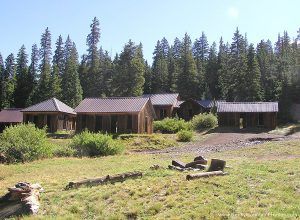
Carson, Colorado by Mike Sinnwell, Rocky Mountain Profiles
Wager Gulch-Carson Ghost Town – About 5.5 miles beyond Lake San Cristobal’s south side, the road comes to Wager Gulch. Here, the Alpine Loop intersects with County Road 36, which heads south for about five miles to Carson’s ghost town. The five-mile stretch up Wager Gulch is a rough road that requires a high-clearance, 4-wheel drive vehicle. It actually to the remnants of two old mining camps – Carson and Old Carson. Carson is very well-preserved with several old buildings. As visitors continue west, Red Mountain rises into view as the byway climbs toward the townsite of Sherman. Keep an eye out for bighorn sheep, which are often seen along the rocks in the area.
Sherman Mining Camp – The old mining camp of Sherman is about 4.4 miles west of Wager Gulch. The mining camp was active from the late 1870s through the 1910s but was never very big. There is very little left of the old camp today, but foundations, the remains of collapsed log cabins, and some old equipment. The townsite is located on private property. To get there from Wager Gulch, continue on Co Rd 30 for three miles, then take a slight left onto Co Rd 35 for 1.4 miles to the old townsite. Alternatively, continue past Co Rd 35 to an overlook on Co Rd 30 that provides a birdseye view of the old townsite.
Burrows Park – About four miles beyond Sherman is Burrows Park. Located along the Hinsdale-San Juan County line, Burrows Park is a five-mile-long grassy meadow area that once encompassed several mining camps, including Burrows Park, Whitecross, Tellurium, Argentum, and Sterling. There is little left of these old camps today except two cabins restored by the forest service. This is the starting point for hikes to several nearby fourteeners. In the mountains can be found traces of foundations and the remains of fallen buildings.
American Basin – Just a few miles beyond Burrows Park is the American Basin. Part of the Gunnison National Forest, it is a high alpine basin at an elevation of 12,365 feet surrounded by vertical cliffs. It is well-known for its spectacular scenery and beautiful displays of alpine wildflowers.
Tobasco Mine & Mill – Continue on County Road 30 for about a half a mile to a spur to the right that makes its way for 0.3 miles to the Tobasco Cabin. This is the last standing structure of the old Tobasco Mine and Mill property. Farther up the mountain are the scattered remains of collapsed buildings, foundations, and the mill itself, which is completely collapsed. Several tram towers can also be seen.
Cinnamon Pass – The trail continues along Cinnamon Pass for 1.7 miles before reaching the summit. Cinnamon Pass is one of the highest passes in the San Juan Mountains, sitting at 12,620 feet. The summit provides breathtaking views of the alpine tundra and the high mountain peaks of Handies, Redcloud, and Sunshine, three of the fourteeners in the area. At the summit of Cinnamon Pass, the trail continues westward, leaving Hinsdale County behind and entering San Juan County. The road then becomes San Juan County Road 5 and continues for 2.8 miles to Animas Forks.
Silverton to the Alpine Loop
From Greene Street (Highway 110), the main road through Silverton, turn east onto Blair Street, which becomes County Road 2. This road makes its way northeast through several interesting sites before it arrives at Animas Forks 12 miles later.
Silverton – Established in 1874, Silverton quickly became the center of numerous mining camps and stole the county seat from Howardsville. Today, Silverton is called home to about 630 people. The town’s rich history, coupled with the stunning natural beauty and ample recreation opportunities, draws thousands of visitors and tourists to the area each year.
Arrastra Gulch – From Silverton follow County Road 2 for two miles to Co Rd 52, which veers right off of County Road 2, just before the Mayflower Mill. Co Rd 52 makes its way southeast into Arrastra Gulch, gradually deteriorating along the 2.6-mile trek to the Mayflower Mine. Here, a trailhead climbs 1,050 feet over 1.3 miles to Silver Lake and the Silver Lake Mine. Silver Lake is listed in the Guinness Book of Records for its record snowfall of 76 inches in a 24-hour period in April 1921. Return to Co Rd 2 to continue to the Alpine Loop.
Mayflower Mill – Just beyond Arrastra Gulch is the Mayflower Mill sits on the north side of Co Rd 52. A National Historic Landmark, this mill was the last and the most advanced of the big mills to be built in the San Juan Mountains. Tours of the mill are provided by the San Juan Historical Society in the summer.
Side Spur – Co Rd 4 – Two miles beyond the Mayflower Mill is a side spur on Co Rd 4 that will take travelers to the Old Hundred Mine and the Highland Mary Mine.
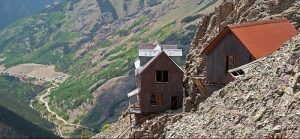
Old Hundred Mine Boarding House by the San Juan County Historical Society
Old Hundred Mine – One mile southeast of Co Rd 2, along the side spur of Co Rd 4, is the Old Hundred Mine. A German named Reinhard Niegold was one of the earliest prospectors to find rich ore on Galena Mountain in 1873. The Old Hundred Mining Company was organized in 1904, and mining occurred sporadically until 1972. Today, the mine can be explored in the summer on a tour that takes visitors 1/3-mile into Galena Mountain.
Highland Mary Mine – This mine is located 5.4 miles south of the Old Hundred Mine on County Road 4, a side spur of the Co Rd 2. Minerals were first discovered here in 1875 by the Ennis brothers. Failing to make a profit, the brothers declared bankruptcy in 1985. In 1907, new owners reopened the mine, which became the second-largest operation in the Silverton area. There are remnants of the old mill today. The Highland Mary Lakes Trailhead is located here to connect with Whitehead Peak Trail and leads south into the Weminuche Wilderness. Return to Co Rd 2 to continue north to the Alpine Loop.
Howardsville – Just a half-mile northeast of the side spur is the old mining camp of Howardsville. Established at Cunningham Gulch’s mouth in 1874, it became one of the largest and most prosperous towns in the area. It was the first Sunnyside Mill site and, in its earliest days, was the county seat of La Plata County before the county was divided up and San Juan County was established in 1876. Today, there are several old buildings at the townsite.
Middleton – Located just 1.6 miles beyond Howardsville once stood the town of Middleton. This community was named because it was in the middle between Howardsville and Eureka. The first claim was made in 1883, and before long, there were over 100 mining claims in the nearby Minnie and Maggie Gulches. There is nothing left of the townsite today, but mining remains can be seen in the area.
Eureka – Just 1.2 miles north of Middleton is the old mining camp of Eureka. Prospecting here dates back to 1860, but the town wasn’t laid out until 1874. The community was primarily supported by the nearby Sunnyside Mine and Mill, located about four miles to the northwest. All that remains of the town today is one small building.
Sunnyside Mine – Continue north on Co Rd 2 for about 0.7 miles to County Road 25, making a sharp left to the southwest. Continue on this road for 3.5 miles to the Sunnyside Mine and Lake Emma. The Sunnyside Mine was first located in 1873 and produced rich gold ore in its early years. The mine changed hands many times but remained in production until 1938. In the 1960s, after completing the 6,233-foot American Tunnel through Bonita Peak to the mining camp of Gladstone, it reopened. However, in 1978, the bottom of Lake Emma broke through and flooded the mine. It was later reopened and operated intermittently until 1999. Return to County Road 2 to continue to Animas Forks.
Alternate Routes to Animas Forks – From County Road 25 that leads to the Sunnyside Mine, Animas Forks can be reached quickly by traveling just 3.8 miles north along Co Rd 2. However, another route makes the trek via County Road 9, situated 2.4 miles north of the road to the Sunnyside Mine.
Side Spur – County Road 9 – This side spur is 3.2 miles north of Eureka or 2.4 miles north of County Road 25, the road to the Sunnyside Mine. Look for a sign reading “Picayune Gulch.” Though this route is longer, it is far more interesting, as it travels along the face of Treasure Mountain then almost to the top of Hanson Peak. This route makes a loop around Treasure Mountain for 7.5 miles and approaches Animas Forks from the west. Along the way are Treasure Mine’s sites, the Sound Democrat mine and mill, the Gold Prince Mine, and the skeletal remains of the Frisco-Bagley Mill and Tunnel. This route can also be traveled in the opposite direction from Animas Forks.
Treasure Mountain Mine – County Road 9 makes a sharp turn back south of County Road 2 and makes its way about west to the Treasure Mountain Mine. In 1881, the Treasure Mountain Mining & Milling Company was founded by Chicago, Illinois investors. Several structures, including a bunkhouse, blacksmith shop, and stamp mill, are located on the south side of the trail. Treasure Mountain gained its name from a local legend of hidden treasure.
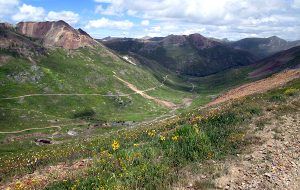
Placer Gulch, Colorado courtesy 4×4 Explore
Placer Gulch – The trail climbs westward out of Picayune Gulch to a high summit dividing Picayune Gulch from Placer Gulch. Here is a parking area and overlook with amazing views in all directions. The road descends into a natural bowl surrounded by Treasure Mountain, California Mountain, Houghton Peak, and Hanson Peak. Here are the ruins of several mines and mills, most notably the Sound Democrat Mill, which sits on a slope on the south bank of Placer Gulch. The collapsed Mastodon Mill is 300 feet to the north on the opposite bank of Placer Gulch, and the ruins of the Hanson or Sunnyside Extension mill are approximately one-half mile to the west at the head of Placer Creek and near the Gold Prince Mine. The ruins of the Gold Prince surface works are one-half mile distant, and the tramway system from the mine to the mill in Animas Forks, approximately 12,000 feet in length, has standing towers and remnants of support structures.
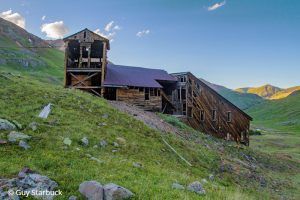
Sound Democrat Mill, courtesy Starbuck’s Exploring.
Sound Democrat Mill –A short spur off the main road leads to the well preserved Sound Democrat Mill built in 1905 and operated until 1914. Powered by electricity, the mill processed ore from the Sound Democrat and Silver Queen mines located on Treasure Mountain’s face to the east. The complex consisted of the two mines, an aerial tramway that transported the ore to the mill, and a surface railway connecting the Silver Queen to the Sound Democrat’s Aerial Tramway. Today, only the mill stands intact, stabilized by the Bureau of Land Management. There are interpretive signs at the complex. Return to County Road 9 and continue north to Animas Forks. The old tramway towers from the Gold Prince Mine to the mill in Animas Forks can still be seen along the way.
Frisco-Bagley Mill and Tunnel – Co Rd 9 continues north for several miles before it turns right (east) to the Frisco Mill and Bagley Tunnel in California Gulch. Built in 1912, this complex once featured several buildings, including a boarding house, compressor house, mine manager’s home, blacksmith shop, and tool shed. Today, the site includes the partially collapsed 150-ton reduction mill, cement foundations that once anchored compressors, and the Bagley Tunnel opening, which is approximately 200 feet away from the mill. The portal to the tunnel is now blocked off, and a stream flows out of it. From here, the road makes its way for about half a mile to Animas Forks.
Contact Information:
For southern parts of the loop:
BLM – San Juan Public Lands Office
15 Burnett Court
Durango, Colorado 81301
970-247-4874
For northern parts of the loop:
BLM – Gunnison Field Office
216 North Colorado Street
Gunnison, Colorado 81230
970-641-0471
©Kathy Weiser-Alexander/Legends of America, updated June 2021.
Also See:
Early Mining and Transportation in Southwestern Colorado
Sources:
Bureau of Land Management
Colorado Department of Transportation
Lake City, Colorado
U.S. Forest Service

